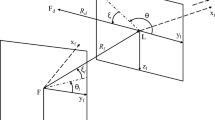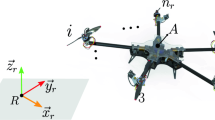Abstract
This paper is concerned with the robust guidance and control of fully actuated multirotor aerial vehicles in the presence of moving obstacles, linear velocity constraints, and matched model uncertainties and disturbances. We address this problem by adopting a hierarchical flight control architecture consisting of a supervisory outer-loop guidance module and an inner-loop stabilizing control one. The position and attitude control laws are designed using a proportional–derivative approach combined with a high-order sliding mode disturbance observer. The resulting inner-loop control strategy is arbitrarily smooth and robust (in the sliding mode sense) with respect to model disturbances and uncertainties. On the other hand, we propose a robust collision-free guidance strategy that extends the continuous-control-obstacles method to drive the vehicle to a target pose under velocity constraints, disturbances, and uncertainties, in an environment containing moving obstacles. The overall method has been numerically evaluated and shown to be effective in providing satisfactory tracking performance, collision-free guidance, satisfaction of linear velocity constraints, and computational viability. Furthermore, it is shown to outperform an analogous scheme based on the original continuous-control-obstacles method and conventional sliding mode inner-loop control laws.











Similar content being viewed by others
Data availability
The datasets generated during and analyzed during the current study are not publicly available, but are available from the corresponding author on reasonable request.
References
Singireddy, S.R.R., Daim, T.U.: Technology Roadmap: Drone Delivery - Amazon Prime Air, pp. 387–412. Springer, Cham (2018)
Heredia, G., Jimenez-Cano, A.E., Sanchez, I., Llorente, D., Vega, V., Braga, J., Acosta, J.A., Ollero, A.: “Control of a multirotor outdoor aerial manipulator. In: IEEE/RSJ International Conference on Intelligent Robots and Systems, pp. 3417–3422 (2014)
Gawel, A., Kamel, M., Novkovic, T., Widauer, J., Schindler, D., von Altishofen, B.P., Siegwart, R., Nieto, J.: Aerial picking and delivery of magnetic objects with mavs. In: IEEE International Conference on Robotics and Automation (ICRA), pp. 5746–5752 (2017)
Park, S., Lee, J., Ahn, J., Kim, M., Her, J., Yang, G.-H., Lee, D.: Odar: aerial manipulation platform enabling omnidirectional wrench generation. IEEE/ASME Trans. Mechatron. 23(4), 1907–1918 (2018)
Ryll, M., Bicego, D., Giurato, M., Lovera, M., Franchi, A.: Fast-hex—a morphing hexarotor: design, mechanical implementation, control and experimental validation. arXiv:2004.06612 (2020)
Ricardo Jr, J.A., Santos, D.A.: Position guidance and control for fully actuated multirotor aerial vehicles in dynamic environments. In: XLIII Ibero-Latin-American Congress on Computational Methods in Engineering (2022)
Rashad, R., Goerres, J., Aarts, R., Engelen, J.B.C., Stramigioli, S.: Fully actuated multirotor UAVS: a literature review. IEEE Robot. Autom. Mag. 27(3), 97–107 (2020)
Ricardo Jr, J.A., Santos, D.A.: Smooth second-order sliding mode control for fully actuated multirotor aerial vehicles. ISA Trans. (2022)
Bezerra, J.A., Santos, D.A.: On the guidance of fully-actuated multirotor aerial vehicles under control allocation constraints using the receding-horizon strategy. ISA Trans. (2021)
Santos, D.A., Lagoa, C.M.: Wayset-based guidance of multirotor aerial vehicles using robust tube-based model predictive control. ISA Trans. 128, 123–135 (2022)
Yu, Y., Shan, D., Benderius, O., Berger, C., Kang, Y.: Formally robust and safe trajectory planning and tracking for autonomous vehicles. IEEE Trans. Intell. Transp. Syst. 23(12), 22971–22987 (2022)
Drajunov, S.V., Utkin, V.I.: Sliding mode control in dynamic systems. Int. J. Control 1029–1037 (1991)
Utkin, V.I.: Sliding Modes in Control and Optimization. Springer, Berlin (1992)
Kotarski, D., Piljek, P., Brezak, H., Kasac, J.: Design of a fully actuated passively tilted multirotor uav with decoupling control system. In: International Conference on Mechanical and Aerospace Engineering, pp. 385–390 (2017)
Yao, C., Krieglstein, J., Janschek, K.: Modeling and sliding mode control of a fully-actuated multirotor with tilted propellers. IFAC-PapersOnLine, vol. 51, pp. 115–120 (2018)
Rajappa, S., Ryll, M., Bülthoff, H., Franchi, A.: Modeling, control and design optimization for a fully-actuated hexarotor aerial vehicle with tilted propellers. In: Proceedings - IEEE International Conference on Robotics and Automation (2015)
Silva, A.L., Santos, D.A.: Fast nonsingular terminal sliding mode flight control for multirotor aerial vehicles. IEEE Trans. Aerosp. Electron. Syst. 56(6), 4288–4299 (2020)
Cömert, C., Kasnakoğlu, C.: Comparing and developing pid and sliding mode controllers for quadrotor. Int. J. Mech. Eng. Robot. Res. 6, 194–199 (2017)
Herrera, M., Chamorro, W., Gómez, A.P., Camacho, O.: Sliding mode control: an approach to control a quadrotor. In: Asia-Pacific Conference on Computer Aided System Engineering, pp. 314–319 (2015)
Eltayeb, A., Rahmat, M.F., Basri, M.A.M., Mahmoud, M.S.: An improved design of integral sliding mode controller for chattering attenuation and trajectory tracking of the quadrotor uav. Arab. J. Sci. Eng. 45(8), 6949–6961 (2020)
Kamel, M., Alonso-Mora, J., Siegwart, R., Nieto, J.: Robust collision avoidance for multiple micro aerial vehicles using nonlinear model predictive control. In: 2017 IEEE/RSJ International Conference on Intelligent Robots and Systems (IROS), pp. 236–243 (2017)
Pereira, J.C., Leite, V.J.S., Raffo, G.V.: An ellipsoidal-polytopic based approach for aggressive navigation using nonlinear model predictive control. In: 2021 International Conference on Unmanned Aircraft Systems (ICUAS), pp. 827–835 (2021)
Bouzid, Y., Bestaoui, Y., Siguerdidjane, H.: Quadrotor-uav optimal coverage path planning in cluttered environment with a limited onboard energy. In: 2017 IEEE/RSJ International Conference on Intelligent Robots and Systems (IROS), pp. 979–984 (2017)
Bareiss, D., Van Den Berg, J.: Reciprocal collision avoidance for robots with linear dynamics using lqr-obstacles. In: 2013 IEEE International Conference on Robotics and Automation, pp. 3847–3853 (2013)
Fiorini, P., Shiller, Z.: Motion planning in dynamic environments using velocity obstacles. Int. J. Robot. Res. 17(7), 760–772 (1998)
Guyy, S.J., Chhugani, J., Kim, C., Satish, N., Lin, M., Manocha, D., Dubey, P.: ClearPath: highly parallel collision avoidance for multi-agent simulation. In: Computer Animation, Conference Proceedings, pp. 177–187 (2009)
Van Der Berg, J., Snape, J., Guy, S.J., Manocha, D.: Reciprocal collision avoidance with acceleration-velocity obstacles. In: Proceedings - IEEE International Conference on Robotics and Automation, pp. 3475–3482 (2011)
Rufli, M., Alonso-Mora, J., Siegwart, R.: Reciprocal collision avoidance with motion continuity constraints. IEEE Trans. Rob. 29(4), 899–912 (2013)
Bareiss, D., Van Den Berg, J.: Generalized reciprocal collision avoidance. Int. J. Robot. Res. 34(12), 1501–1514 (2015)
Markley, F.L., Crassidis, J.L.: Fundamentals of Spacecraft Attitude Determination and Control, ser. Space Technology Library. Springer, New York (2014)
Goldstein, H.: Classical Mechanics. Addison-Wesley, Boston (1980)
Khan, W., Nahon, M.: A propeller model for general forward flight conditions. Int. J. Intell. Unmanned Syst. 3(2/3), 72–92 (2015)
Levant, A.: Higher-order sliding modes, differentiation and output-feedback control. Int. J. Control 76(9–10), 924–941 (2003)
Shtessel, Y.B., Shkolnikov, I.A., Levant, A.: Smooth second-order sliding modes: missile guidance application. Automatica 43(8), 614–619 (2007)
Fang, Y., Hu, J., Liu, W., Shao, Q., Qi, J., Peng, Y.: Smooth and time-optimal s-curve trajectory planning for automated robots and machines. Mech. Mach. Theory 137, 127–153 (2019)
Ricardo Jr, J.A., Santos, D.A.: Robot guidance and control using global sliding modes and acceleration velocity obstacles. In: International Workshop on Variable Structure Systems and Sliding Mode Control (2022)
Van Der Berg, J., Lin, M., Manocha, D.: Reciprocal velocity obstacles for real-time multi-agent navigation. IEEE Trans. Rob. 23(4), 834–834 (2007)
Acknowledgements
This work was supported by the São Paulo Research Foundation (FAPESP) under Grant 2019/053340; Coordination of Superior Level Staff Improvement (CAPES), EMBRAER S.A., and the Aeronautics Institute of Technology (ITA) under the doctorate scholarship under the Academic-Industrial Graduate Program (DAI); National Council for Scientific and Technological Development (CNPq), under Grant 304300/2021-7; and Funding Authority for Studies and Projects (FINEP) under Grant 01.22.0069.00.
Author information
Authors and Affiliations
Corresponding author
Ethics declarations
Conflict of interest
The authors have no relevant financial or non-financial interests to disclose.
Additional information
Publisher's Note
Springer Nature remains neutral with regard to jurisdictional claims in published maps and institutional affiliations.
Proof of Lemma 3
Proof of Lemma 3
The solution of the position reference filter differential equation (32) is given by
where \(\delta t\triangleq t - t_0\).
The integral of (49) cannot be directly calculated since matrix \({\textbf {A}}\) is singular. To analytically calculate (49), we consider \( {{{\textbf {v}}}}_r^*\) as a constant input and define an augmented vector \({\textbf {w}} \triangleq ({\textbf {y}}, {{{\textbf {v}}}}_r^*)\in {\mathbb {R}}^{(3p+6)}\). Then, using (32) we can write the following dynamic model
where
The solution of (50) is easily calculated and is given by \({\textbf {w}}(t) = e^{\bar{{\textbf {A}}}(\delta t)}{} {\textbf {w}}(0)\). Using the power series definition of matrix exponential, \(e^{\bar{{\textbf {A}}}(\delta t)}\) can be calculated by
Then, using (51), equation (49) can be rewritten as \( {{\textbf {y}}}(t) = e^{{\textbf {A}}\delta t}{{\textbf {y}}}(t_0) + {\textbf {G}}(\delta t) {{{\textbf {v}}}}_r^*,\) where
thus completing the proof. \(\square \)
Rights and permissions
Springer Nature or its licensor (e.g. a society or other partner) holds exclusive rights to this article under a publishing agreement with the author(s) or other rightsholder(s); author self-archiving of the accepted manuscript version of this article is solely governed by the terms of such publishing agreement and applicable law.
About this article
Cite this article
Ricardo, J.A., Santos, D.A. Robust collision-free guidance and control for fully actuated multirotor aerial vehicles. Nonlinear Dyn 111, 21007–21023 (2023). https://doi.org/10.1007/s11071-023-08927-4
Received:
Accepted:
Published:
Issue Date:
DOI: https://doi.org/10.1007/s11071-023-08927-4




